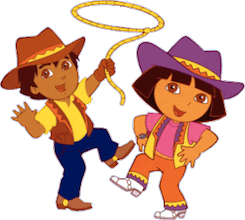10 Ways Cartoons Help Kids Learn About Different Cultures
August 26, 2012 | in Nannies
 Learning about cultures and ways of life that are different from those that your children are familiar with is an important part of growing up; as he ages and spends more time with people outside of his immediate family and childcare providers, he will encounter an entire world of people whose ideas and customs are different from his own. Though there has been a significant push in severely limiting or eliminating kids’ exposure to television shows, there are some valuable lessons that children can learn from these brightly colored animated adventures.
Learning about cultures and ways of life that are different from those that your children are familiar with is an important part of growing up; as he ages and spends more time with people outside of his immediate family and childcare providers, he will encounter an entire world of people whose ideas and customs are different from his own. Though there has been a significant push in severely limiting or eliminating kids’ exposure to television shows, there are some valuable lessons that children can learn from these brightly colored animated adventures.
- Focusing on Cultural Diversity Education – Some cartoons, like The Misadventures of Maya and Miguel, are focused primarily on both presenting realistic depictions of different ethnicities to non-minority children and providing children from similar ethnic backgrounds with characters that look, sound, and live the same way they do.
- Depicting Everyday Situations – Rather than underscoring every reference to non-minority culture with heavy-handed preaching, cartoons tend to center around characters in ordinary situations (or extraordinary, if the shows are fantasy-based) that simply happen to be from a different cultural background.
- Featuring Characters from Various Ethnic Backgrounds and Walks of Life – Cartoons that feature large groups of characters working together, striving for a common goal, or simply interacting with one another regularly tend to do so with a racially and culturally mixed group. The things that make these characters different may be touched upon in specific episodes, but they’re most often simply accepted, as the main focus is on finding adventures or overcoming obstacles together.
- Musical Diversity – Music and children’s television tend to go hand in hand, and cartoons that feature diverse “casts” also tend to include music from a variety of cultural and ethnic backgrounds. Kids may be prompted to sing along with their favorite characters in another language, or mimic dances associated with other cultures.
- Discussing Cultural Ceremonies and Traditions – Jewish characters may discuss a bar or bat mitzvah, animated Latina girls may get excited about their quinceanera, and Christian cartoon characters often celebrate Christmas or other religious holidays. These frank depictions of cultural ceremonies observed by characters from various backgrounds and ethnicities help kids to see beyond the scope of the ones celebrated in their own households.
- Foreign Language Instruction – Cartoon juggernaut Dora the Explorer opened the floodgates for early education in second languages; while she still holds the crown as the undisputed princess of animated language instruction, followers like Ni Hao, Kai-Lan and others of her ilk have created an entire cartoon subculture centered around teaching diversity by teaching basic second-language vocabulary.
- Creating Talking Points for Parents and Kids – When kids watch cartoons and are exposed to unfamiliar cultural and ethnic depictions, their natural reaction is to question their parents and caregivers about the things that they don’t understand. By presenting different cultures and diverse groups to small children, cartoons are also presenting parents with a priceless opportunity to discuss such things with them.
- Eschewing Stereotypes – In cartoons, a girl might take the lead while a boy shows reticence; stereotypes are broken and disregarded in cartoons today. While this attitude is in direct opposition to the sometimes-racist cartoons with rigid gender roles in the days of yore, kids today are not being conditioned by their animated entertainment to view the world in such ways.
- Presenting Diversity to Culturally Isolated Kids – Some kids grow up in rural areas, or fairly homogenous neighborhoods, and have limited interaction with kids from other backgrounds. For these kids, high-quality cartoons provide a glimpse into those backgrounds and expose them to cultural differences that they might otherwise be unaware of.
- Direct Imports – It’s difficult to dispute the huge impact that Japanese cartoons have had on the global landscape. Collecting and merchandising crazes spurred by imported shows like Pokemon are the stuff of legend; they’re also chock full of references to Japanese culture, more often than not.
Exposure to high-quality children’s programming, in moderation and paired with a significant amount of physically active play, can help kids form a well-rounded world view at an early age. Screening the shows that your kids watch for any questionable content, like excessive violence or lack of educational merit, can help you find shows that keep your kids entertained as they learn; rather than taking an all-or-nothing approach to children’s television, allowing a limited amount of high quality programming that introduces them to new concepts and ways of life might actually prove to be beneficial.
← 10 Ways To Recognize Your Nanny During National Nanny Recognition Week | 10 Things Kids Learned from Mister Rogers →Comments are closed.
DIY & Sign up Online
We have partnered with eNannySource to help you search for the perfect nanny in your area in addition to our other services.
Enter your zipcode to get started:
Nanny Articles
- How to Calm Back to School Jitters
- What to Include in Your Nanny’s Annual Review
- 25 Blogs Featuring the Most Inspiring Parenting Stories
- Crazy Things Kids Say About Old People
- 21 Blogs with Insightful Tips for Helping Kids Through a Move
- Is Lying to Your Kids About the Tooth Fairy Wrong?
- 21 Blogs Making Fun Homemade Mixtures for the Kids to Get Their Hands Into
- 10 of the Most Hated Cartoon Characters by Moms of All Time
- How to Hide Electrical Wires from Computers, TVs and Small Appliances
- 30 Blogs with the Best Tips on Helping Your Child Prepare for Standardized Testing
National Nannies History
- Pillow Agreement Definition
- Retroactive Caregiver Agreement
- What Is Condition and Warranty in Contract Law
- Shared Ownership Contract Template
- How to Start Labour Contract Business
- Prenuptial Agreement in Bengali
- State of Nj Installment Agreement
- When Does an Agreement Become Unconditional
- Illinois Contract Law Impossibility of Performance
- Service Agreement Francais
- Group Contains a Subject and a Verb in Agreement
- Tenant Commercial Lease Agreement
- Indigo Card Agreement
- Home Improvement Contractors License Louisiana
- The Contracts Rights of Third Parties Act 1999 Shall Not Apply to This Agreement
- Taliban Agreement Text
- 6 Months or 12 Months Tenancy Agreement
- Property Management Agreements Should Include the following except
- Agent Contracting with Humana
- Nrcan Collective Agreement


